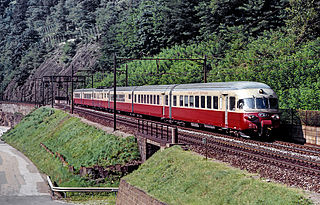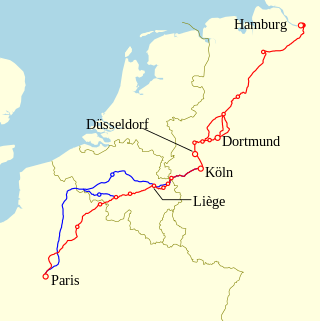
The RAe TEE II, later known as RABe EC, is a type of high-speed electric multiple unit trainset of the Swiss Federal Railways (SBB-CFF-FFS), which was used from the 1960s until the 1980s on several Trans Europ Express services. After conversion from first-class-only to two-class configuration, the trainsets continued in use on EuroCity or other services until 1999.

The Arbalète was an express train that linked Paris-Est in Paris, France, with Zürich HB in Zurich, Switzerland. Introduced in 1957, it was operated by the SNCF and the Swiss Federal Railways (SBB-CFF-FFS).

The Cisalpin was an express train that linked Paris-Gare de Lyon in Paris, France, with Milano Centrale in Milan, Italy. Introduced in 1961, it was operated by the SNCF, the Swiss Federal Railways (SBB-CFF-FFS) and the Italian State Railways (FS).

The Iris was an express train that linked Brussels Midi/Zuid in Brussels, Belgium, with Chur station in Chur, Switzerland.

Le Mistral, or the Mistral, was an express train between Paris and Nice in France. Introduced in 1950, it was operated by the Société Nationale des Chemins de fer français (SNCF), and was regarded as the company's flagship train.

The word Rheinpfeil was used to name a number of express trains that ran in Germany between the 1950s and 1991. For much of that period, a train carrying the name Rheinpfeil also linked Germany with at least one neighbouring country.

The Roland was an express train that ran in Germany. For part of its existence, it was also an international train. Introduced in 1939, suspended during World War II, and reintroduced in 1952, it was operated in Germany by the Deutsche Reichsbahn Gesellschaft (DRG), the Deutsche Bundesbahn (DB) and the Deutsche Bahn (DB), respectively.

The word Mediolanum has been used to name three distinct international express trains that have run to and from Milano Centrale in Milan, Italy since 1957. The focus of these trains on the city now known as Milan reflects the fact that Mediolanum is the Latin word for ancient Milan.

The Catalan Talgo was an international express train that linked Geneva, Switzerland, with Barcelona, Spain from 1969 to 2010. It was named after the Spanish region Catalonia and the Talgo equipment it used. It was an extension and upgrading of a predecessor train, Le Catalan, a first-class-only French (SNCF) Rapide train that had been in operation since 1955 but running only between Geneva and the stations nearest the Spanish-French border, connecting with a second-class-only "autorail" trainset to and from Barcelona. The national railway network of Spain, Red Nacional de los Ferrocarriles Españoles (RENFE), was using Iberian gauge for all of its main lines, while those of France and Switzerland use standard gauge. As a result of this break-of-gauge, train journeys between Geneva and Barcelona consisted of two separate parts, with travelers having to change from a French to a Spanish train or vice versa at the border—at Portbou on southbound trains and at Cerbère on northbound trains. In 1968, this was resolved with the introduction of the Talgo III RD trainsets, which featured variable gauge wheelsets. At Portbou station, the wheel spacing of each passenger carriage was adjusted by a gauge changer for the difference in gauge, and passengers no longer had to change trains. After successful test runs, the Catalan was extended from Port Bou to Barcelona as a through train on 1 June 1969, becoming the Catalan Talgo and upgraded to a Trans Europ Express (TEE). Most other rail journeys through this border crossing continued to require a change of train at Cerbère station or at Port Bou, as most trains did not use Talgo III RD trainsets.
The Diamant was an express train operated by the Deutsche Bundesbahn (DB), using different routes over the years. The name Diamant, Dutch for diamond, refers to the city of Antwerp, which is the European centre of diamond trade and has a diamond district. The initial service started in 1962 as a first-class-only FernTriebwagen linking the West-German capital Bonn with Antwerp, using a class DB Class VT 08 diesel multiple unit (DMU).

The Ligure was an international express train operated by the Italian Railways linking Milan with the Côte d'Azur. The train was named after the Italian region Liguria which was served by the train.

The Jules Verne was an express train that linked Paris and Nantes in France. Operated by the Société Nationale des Chemins de fer français (SNCF), it was the last new Trans Europ Express (TEE) to be introduced, in 1980.

The Mont Cenis was an international express train linking Lyon in France with Milan in Italy. The train was named after the mountain range through which it crossed, inside the Fréjus Rail Tunnel on the French-Italian border.

The Ticino was an express train that linked Milan in Italy, with Zürich, Switzerland and for some years even to Munich, Germany. The train was named after the Canton of Ticino in the south of Switzerland. Introduced in 1961, it was a first-class-only Trans Europ Express (TEE) service until 1974. Later, it was a EuroCity service.

The Paris–Ruhr was an express train that linked Paris in France, with Dortmund in Germany. The train was named after its two termini, Paris in the west and the Ruhr district in the east. For most of its life, it was a Trans Europ Express (TEE).

The Rembrandt was an express train that linked Amsterdam in the Netherlands, with Munich in Germany and later Chur in Switzerland. The train was named after the renowned Dutch painter Rembrandt. For its first 16 years it was a first-class-only Trans Europ Express, becoming a two-class InterCity in 1983 and finally a EuroCity in 1987.

The Parsifal was an express train that linked Paris with Dortmund in Germany and later Cologne. The train was named after Wagner's opera inspired by the legendary knight Percival.

The Vesuvio was an express train in Italy, linking Milan and Naples. The train was named after Mount Vesuvius the volcano near Naples.
The Cycnus was an express train operated by Ferrovie dello Stato, linking Milan with Ventimiglia, Italy. Cycnus literally means swan, but more likely the name refers to the mythological King of Liguria, the region the train served.

The Van Beethoven was an international train linking the Dutch capital Amsterdam and the West German capital Bonn. The train was named after the Bonn-born composer Ludwig van Beethoven.



















